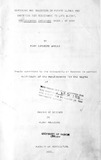| dc.contributor.author | Wabule, M N | |
| dc.date.accessioned | 2013-07-03T12:47:14Z | |
| dc.date.available | 2013-07-03T12:47:14Z | |
| dc.date.issued | 1981 | |
| dc.identifier.citation | Wabule, M. N(1981). Screening and selection of potato clones and varieties for resistance to late blight phytophthora infestans (mont.) de bary. Msc thesis- UoN | en |
| dc.identifier.uri | http://erepository.uonbi.ac.ke:8080/xmlui/handle/123456789/44732 | |
| dc.description | Msc thesis | en |
| dc.description.abstract | Late blight caused by Phytophthora infestans (Mont.) de Bary is one of the most destructive diseases which limits the production of potatoes in Kenya. Most of the potatoes are produced by small-scale farmers who cannot affort to spray their crops effectively due to the high costs involved. Therefore, screening and breeding of clones to develop resistant varieties is necessary to avoid the expensive chemical method of control.
Initial screening consisted of field and laboratory testing of 226 clones followed by yield evaluation of selected clones at Tigoni, N.A.L., Nairobi and Molo. The laboratory screening included physical, anatomical and biochemical tests. The physical test consisted of inoculating whole plants and detached leaflets artificially and estimating the percentage leaf area infected, period of infection and sporulation, lesion size and number of sporangia produced. Results indicated that laboratory tests were more severe than field test in separating the resistant lines from susceptible ones. The laborary tests also indicated that some of the clones had a higher level of horizontal resistance than others while some appeared to have oligogenic resistance.
The anatomical test consisted of micrtome sectioning of leaves and stems and measuring the thickness of the epidermal cells. There was no correlation between the degree of resistance and the thickness of these cells.
The biochemical test involved determinatin of total phenolic compounds in healthy leaves colorimetrically by “Folin-Ciocalteu” reagent. Results showed a positive correlation between the level of resistance and the amount of phenolic determined.
Results of tuber inoculation indicated that in some clones there was a correlation between haulm resistance and tuber resistance while other clones did not show this correlation. Further tests involved nutritional studies where crude protein content, dry matter content, and cooking test revealed that potatoes could be a good source of proteins apart from supplying carbohydrates. The texture and f | en |
| dc.language.iso | en | en |
| dc.subject | Potato clones | en |
| dc.subject | Late bright phytophthora infestans( mont.) | en |
| dc.subject | De bary | en |
| dc.title | Screening and selection of potato clones and varieties for resistance to late blight phytophthora infestans (mont.) de bary | en |
| dc.type | Thesis | en |
| local.publisher | Department of Plant Science and Crop Protection, University of Nairobi | en |

